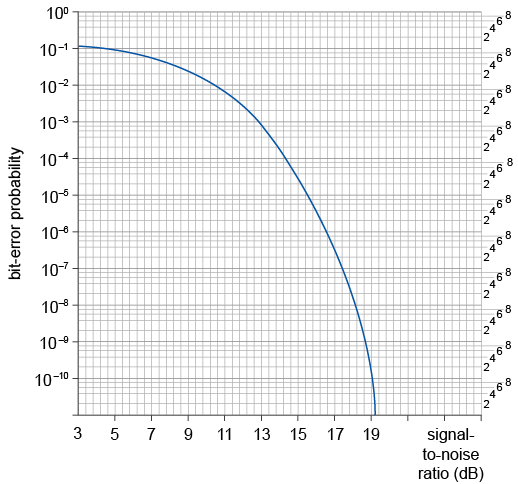The numbers on the right of Figure 2 are multipliers. For example, working upwards from the horizontal line representing 10–10, the next horizontal line up represents 2 × 10–10; the next line up represents 4 × 10–10, and so on. The next line up from 8 × 10–10 has no number on the right and represents 10 × 10–10, which is 10–9, as shown on the vertical axis on the left. In mobile cellular communications, the signal-to-noise ratio is often poor, particularly indoors. Suppose that at an indoor location the signal-to-noise ratio is 7 dB. What would the corresponding bit-error probability be? A rule-of-thumb in mobile communications engineering is that the signal-to-noise ratio indoors is 10 dB worse than outdoors at the same location. Using this rule-of-thumb, what would the bit-error probability be outdoors at the same location as in (a)? By what factor has the signal-to-noise ratio improved by moving from indoors to outdoors? Express this as an ordinary number rather than in decibels. By what factor has the bit error rate improved as a result of the move?
Figure 2 Bit error graph (image insterted)
The numbers on the right of Figure 2 are multipliers. For example, working upwards from the horizontal line representing 10–10, the next horizontal line up represents 2 × 10–10; the next line up represents 4 × 10–10, and so on. The next line up from 8 × 10–10 has no number on the right and represents 10 × 10–10, which is 10–9, as shown on the vertical axis on the left.
In mobile cellular communications, the signal-to-noise ratio is often poor, particularly indoors. Suppose that at an indoor location the signal-to-noise ratio is 7 dB.
What would the corresponding bit-error probability be?
A rule-of-thumb in mobile communications engineering is that the signal-to-noise ratio indoors is 10 dB worse than outdoors at the same location. Using this rule-of-thumb, what would the bit-error probability be outdoors at the same location as in (a)?
By what factor has the signal-to-noise ratio improved by moving from indoors to outdoors? Express this as an ordinary number rather than in decibels. By what factor has the bit error rate improved as a result of the move?

Step by step
Solved in 3 steps with 10 images









